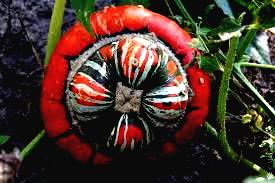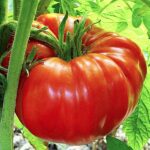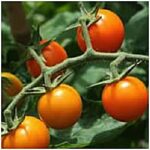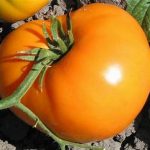Squash – Turks Turban
€2.95
Description
Squash – Turks Turban is a brightly coloured squash usually grown for ornamental purposes. In addition it is very tasty when picked young and stuffed with rice or meat.
Sowing:
Sow individual seeds about 2-3 cm deep into pots (9cm) filled with good compost between late April to early May. Plant out in late May/June. Ideally protect the new plants with a cloche for the first week.
Approx. seed count: 5 sds
Growing squash:
“Winter squashes are the forgotten vegetables. Almost no vegetable is as easy to grow or keep. With fertile soil, full sun and ample water, vines take off. And after plants become established, they’re so carefree, it’s easy to forget them until fall when their rediscovery makes the harvest that much sweeter”- Andy Tomolonis
Family:
Cucurbitaceae
Related to:
Courgette, marrow, cucumber and melon.
Introduction:
Squash – Turks Turban is one of the most vigorous vegetables. Some varieties can easily cover an area of 5 square meters, rambling over any neighbouring crop. Therefore they are not well suited to a small garden. You can, however, experiment growing them in more unusual places – on top of an old compost heap, up trellises etc.
There are two types of squashes:
- Summer squashes
- Winter squashes
For both types there are bush and trailing varieties. The bush plants are a lot better behaved and require a lot less space than the trailing varieties, but the yield is lower.
Summer squashes are grown and harvested like courgettes. There are only a few varieties available, but some of them are excellent.
Winter squashes are grown for storage. The fruit is harvested in October before the first frost and stored. There is a massive choice of varieties available. Immature fruits of winter squash can also be used throughout the season.
History:
The name ‘Squash’ is an abbreviation of the native American word askutashash which means ‘eaten raw or uncooked’.
Soil and site:
Squashes need a very fertile, free-draining soil which can hold plenty of moisture. However, a generous application of well-decomposed compost is beneficial (about 1 bucket per square meter).
They also need a sheltered place in the garden because they really despise strong wind.
Sowing:
Squashes are very tender plants.
I usually sow seeds in early May individually into 7cm pots. The pots are left ideally in a propagator in the greenhouse or on the windowsill at home (south facing). They may also be okay in a tunnel without a propagator, but plants have to be covered up with fleece during cold spells in order to protect them from frost damage.
After about 3 weeks – or before the plants get pot bound – I pot them on into 12cm pots which are still left in the greenhouse or indoors.
Planting:
Start hardening the plants off at the end of May and then plant out in early June. Do not plant if the weather forecast predicts cold windy spells which are quite common during this time.
The safest way would be to plant them under cloches which are covered with bio-net.
Spacing:
Bush varieties: 1.2m apart each way.
Trailing varieties: 2m apart each way.
Rotation:
Squashes belong to the cucurbit family. This family is not prone to any soil borne pests and diseases, so you do not need to be too fussy with rotations.
Plant care:
Keep the plants weed free, especially in the early stages because it will be very difficult later on to get to the weeds. In addition if it is well weeded at the start the large leaves will prevent new seeds from germinating.
As with pumpkins, squashes may try to grow over neighbouring vegetables, so they need to be kept in check, either by shortening some shoots or by moving them back to their allocated space.
Hand pollination: In cold, wet weather (when few insects are around) you can pollinate the flowers by hand. This will increase your chances to get fruits.
Squash plants have separate male and female flowers. They are easily distinguished by looking at the flower stalk. The male stalk is plain and the female flower carries a small fruit on the stalk.
You transfer the pollen from the male to the female flowers with a soft brush or remove the male flower and rub it onto the open blooms of the female flowers.
Harvesting and storing:
If you want to store squashes, leave the fruits to mature on the vine at least until October. The mature fruits have hard outer shells. Use a sharp knife to cut the stems (or handles) of the fruits to be stored. Leave the stem attached to the fruit. If the leaves of the plants are still green that means that the fruit is not yet cured and will not store for long. Then you should leave the fruits out in a sunny spot for about ten days and only move them in if frost threatens. As they will then store well in a dry, fairly cool location until March.
Potential problems:
Squash – Turks Turban needs to be protected from slugs at the early stages straight after planting out. Like all other cucurbits they are very sensitive to cold and windy weather. It is highly beneficial to plant them under a cloche covered with bionet for the first month.
During unfavourable weather they may fail to set fruit. You may have to do some ‘artificial insemination’ (see hand pollinating).
How much to grow?
Two to three plants are sufficient otherwise you will have no room left for anything else. Squashes, however are exciting plants to grow and the fact that there are so many different varieties around, makes it very difficult to restrict yourself to just a few plants.
Why not subscribe to my monthly gardening newsletter?
https://greenvegetableseeds.com/newsletters/




